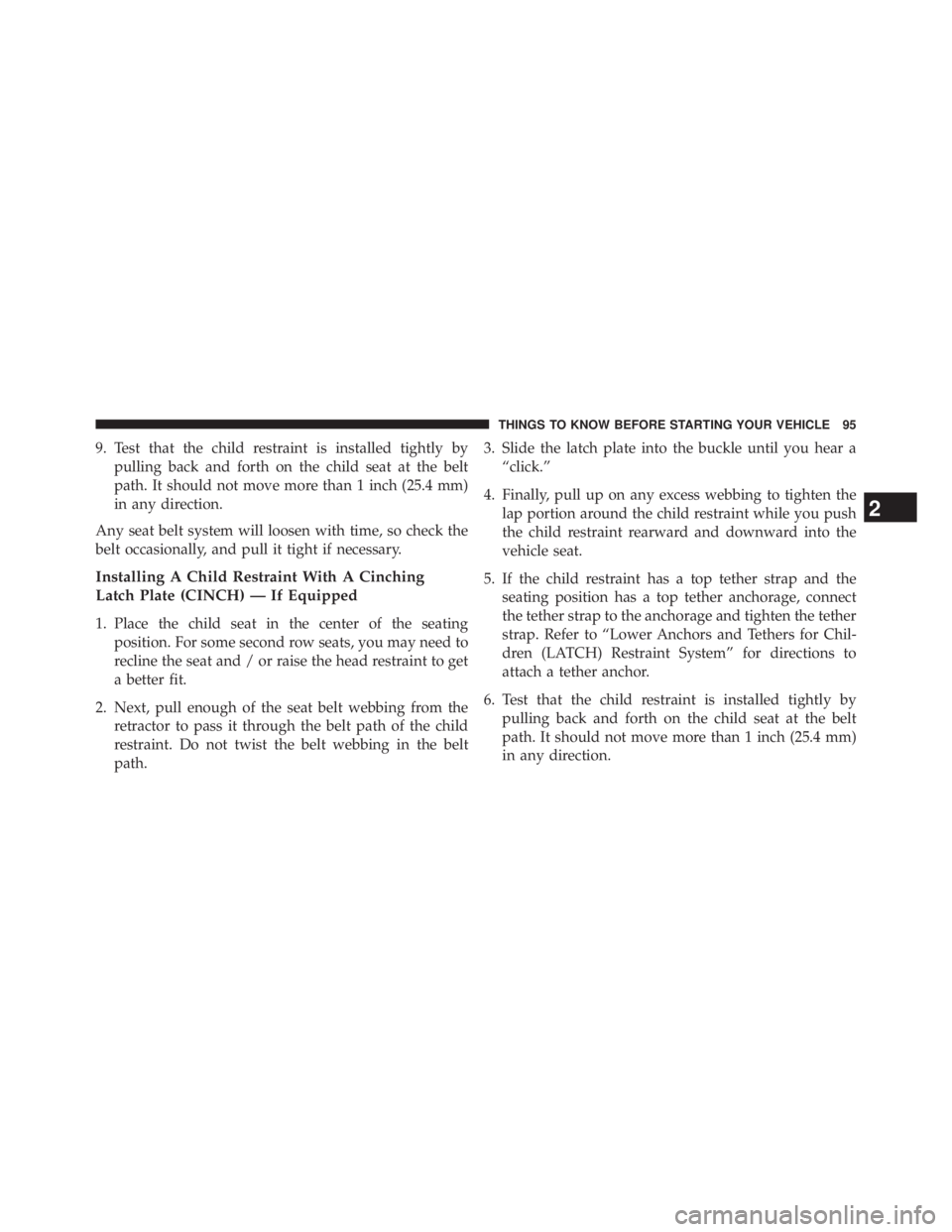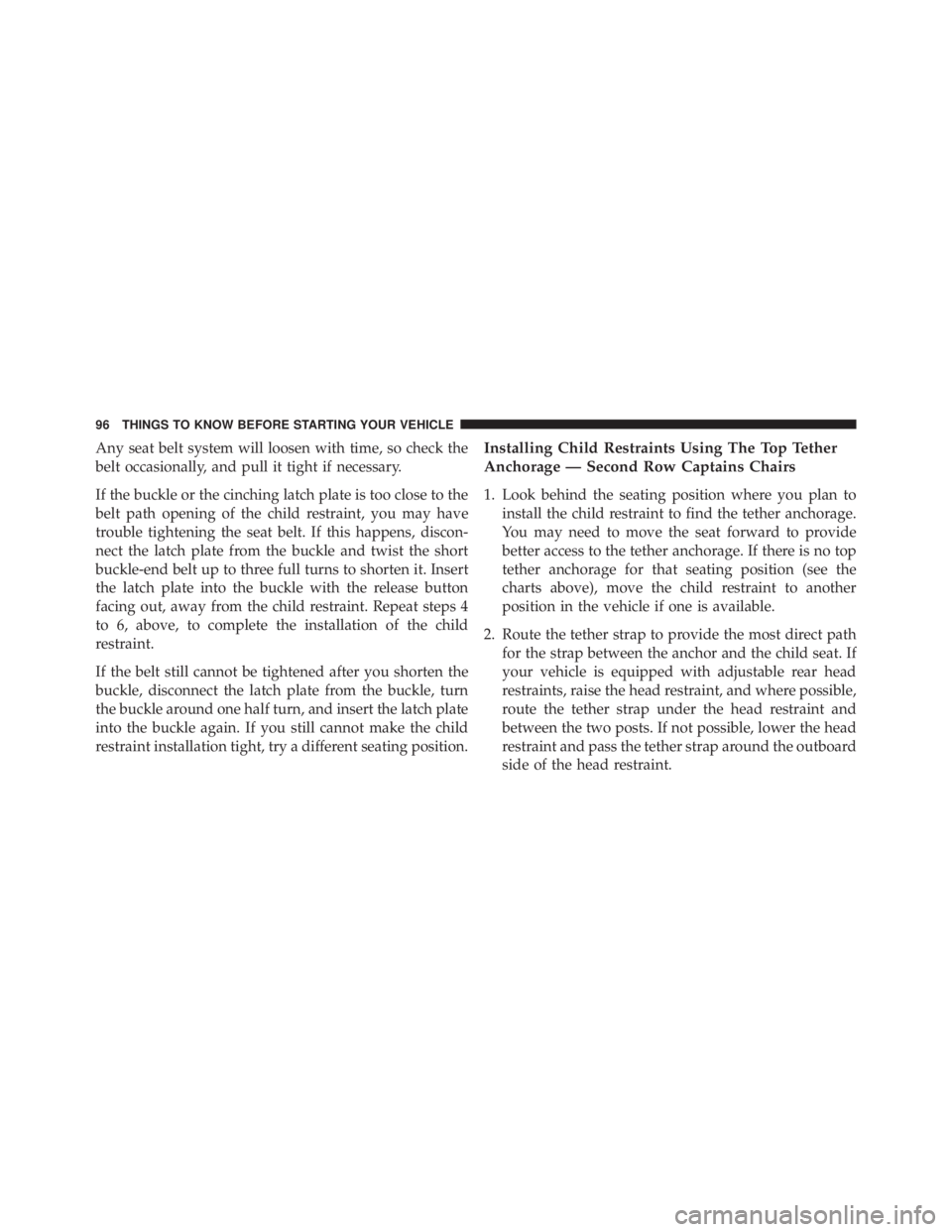Page 97 of 655

9. Test that the child restraint is installed tightly by
pulling back and forth on the child seat at the belt
path. It should not move more than 1 inch (25.4 mm)
in any direction.
Any seat belt system will loosen with time, so check the
belt occasionally, and pull it tight if necessary.
Installing A Child Restraint With A Cinching
Latch Plate (CINCH) — If Equipped
1. Place the child seat in the center of the seating
position. For some second row seats, you may need to
recline the seat and / or raise the head restraint to get
a better fit.
2. Next, pull enough of the seat belt webbing from the
retractor to pass it through the belt path of the child
restraint. Do not twist the belt webbing in the belt
path. 3. Slide the latch plate into the buckle until you hear a
“click.”
4. Finally, pull up on any excess webbing to tighten the
lap portion around the child restraint while you push
the child restraint rearward and downward into the
vehicle seat.
5. If the child restraint has a top tether strap and the
seating position has a top tether anchorage, connect
the tether strap to the anchorage and tighten the tether
strap. Refer to “Lower Anchors and Tethers for Chil-
dren (LATCH) Restraint System” for directions to
attach a tether anchor.
6. Test that the child restraint is installed tightly by
pulling back and forth on the child seat at the belt
path. It should not move more than 1 inch (25.4 mm)
in any direction. 2 THINGS TO KNOW BEFORE STARTING YOUR VEHICLE 95
Page 98 of 655

Any seat belt system will loosen with time, so check the
belt occasionally, and pull it tight if necessary.
If the buckle or the cinching latch plate is too close to the
belt path opening of the child restraint, you may have
trouble tightening the seat belt. If this happens, discon-
nect the latch plate from the buckle and twist the short
buckle-end belt up to three full turns to shorten it. Insert
the latch plate into the buckle with the release button
facing out, away from the child restraint. Repeat steps 4
to 6, above, to complete the installation of the child
restraint.
If the belt still cannot be tightened after you shorten the
buckle, disconnect the latch plate from the buckle, turn
the buckle around one half turn, and insert the latch plate
into the buckle again. If you still cannot make the child
restraint installation tight, try a different seating position. Installing Child Restraints Using The Top Tether
Anchorage — Second Row Captains Chairs
1. Look behind the seating position where you plan to
install the child restraint to find the tether anchorage.
You may need to move the seat forward to provide
better access to the tether anchorage. If there is no top
tether anchorage for that seating position (see the
charts above), move the child restraint to another
position in the vehicle if one is available.
2. Route the tether strap to provide the most direct path
for the strap between the anchor and the child seat. If
your vehicle is equipped with adjustable rear head
restraints, raise the head restraint, and where possible,
route the tether strap under the head restraint and
between the two posts. If not possible, lower the head
restraint and pass the tether strap around the outboard
side of the head restraint.96 THINGS TO KNOW BEFORE STARTING YOUR VEHICLE
Page 99 of 655
3. Attach the tether strap hook of the child restraint to
the top tether anchorage as shown in the diagram.
4. Remove slack in the tether strap according to the child
restraint manufacturer ’s instructions.Tether Strap Mounting (Two-Door Models) Tether Strap Mounting (Four-Door Models)
2 THINGS TO KNOW BEFORE STARTING YOUR VEHICLE 97
Page 100 of 655

WARNING!• An incorrectly anchored tether strap could lead to
increased head motion and possible injury to the
child. Use only the anchorage position directly
behind the child seat to secure a child restraint top
tether strap.
• If your vehicle is equipped with a split rear seat,
make sure the tether strap does not slip into the
opening between the seatbacks as you remove
slack in the strap.
Transporting Pets
Air Bags deploying in the front seat could harm your pet.
An unrestrained pet will be thrown about and possibly
injured, or injure a passenger during panic braking or in
a collision.
Pets should be restrained in the rear seat in pet harnesses
or pet carriers that are secured by seat belts. ENGINE BREAK-IN RECOMMENDATIONS
A long break-in period is not required for the engine and
drivetrain (transmission and axle) in your vehicle.
Drive moderately during the first 500 miles (800 km).
After the initial 60 miles (100 km), speeds up to 50 or
55 mph (80 or 90 km/h) are desirable.
While cruising, brief full-throttle acceleration within the
limits of local traffic laws contributes to a good break-in.
Wide-open throttle acceleration in low gear can be detri-
mental and should be avoided. Trailer tow is not recom-
mended during break in period.
The engine oil installed in the engine at the factory is a
high-quality energy conserving type lubricant. Oil
changes should be consistent with anticipated climate
conditions under which vehicle operations will occur.98 THINGS TO KNOW BEFORE STARTING YOUR VEHICLE
Page 163 of 655
Front Head Restraints
To raise the head restraint, pull upward on the head
restraint. To lower the head restraint, press the adjust-
ment button, located on the base of the head restraint,
and push downward on the head restraint. Rear Head Restraints
The rear seat is equipped with nonadjustable head re-
straints. Refer to “Occupant Restraints” in “Things to
Know Before Starting Your Vehicle” for information on
child seat tether routing.
Fold And Tumble Rear Seat — Two-Door Models
NOTE:
• Prior to folding the rear seat, it may be necessary to
reposition the front seats.
• Be sure that the front seats are fully upright and
positioned forward. This will allow the rear seat to fold
down easily.
Adjustment Button
3 UNDERSTANDING THE FEATURES OF YOUR VEHICLE 161
Page 210 of 655
Install the seat attachment strap (at the top of the bag)
through the loops. Lift the Freedom bag into the vehicle with the hooks and
straps facing the back of the rear seat. Attach the clips at
the bottom of the bag to the child restraint anchorages,
located at the base of the rear seat.208 UNDERSTANDING THE FEATURES OF YOUR VEHICLE
Page 638 of 655

Chart, Tire Sizing ........................ .473
Check Engine Light
(Malfunction Indicator Light) ...............311
Checking Your Vehicle For Safety ...............99
Checks, Safety ............................99
Child Restraint ............................76
Child Safety Locks .........................40
Clean Air Gasoline ....................... .507
Cleaning
Wheels ............................. .593
Climate Control ......................... .391
Clock ................................. .337
Cold Weather Operation ....................411
Compact Disc (CD) Maintenance ............. .390
Compact Spare Tire ....................... .487
Compass .............................. .315
Compass Calibration ...................... .318
Compass Variance ........................ .317
Computer, Trip/Travel ..................... .315 Connector
UCI ............................... .382
Universal Consumer Interface (UCI) ........ .382
Console ............................... .189
Console, Floor .......................... .189
Contract, Service ......................... .627
Coolant Pressure Cap (Radiator Cap) .......... .580
Cooling System .......................... .577
Adding Coolant (Antifreeze) .............. .579
Coolant Capacity ...................... .610
Coolant Level ........................ .581
Disposal of Used Coolant ................ .581
Drain, Flush, and Refill ................. .578
Inspection ........................... .577
Points to Remember .................... .581
Pressure Cap ......................... .580
Radiator Cap ......................... .580
Selection of Coolant (Antifreeze) ........... .578
Corrosion Protection ...................... .591636 INDEX
Page 648 of 655

Rear Window Features .................... .293
Rear Wiper/Washer ....................... .293
Recorder, Event Data .......................75
Recreational Towing ...................... .532
Shifting into Transfer Case Neutral (N) ...... .534
Shifting out of Transfer Case Neutral (N) ..... .536
Reformulated Gasoline .................... .507
Refrigerant ............................. .572
Release, Hood ........................... .166
Reminder, Seat Belt .........................59
Remote Control
Door Locks ............................22
Starting System .........................28
Remote Keyless Entry (RKE) ..................22
Remote Sound System (Radio) Controls ........ .389
Remote Starting System ......................28
Replacement Bulbs ....................... .606
Replacement Keys .........................17
Replacement Parts ........................ .564 Replacement Tires ........................ .491
Reporting Safety Defects ................... .629
Resetting Oil Change Indicator ............... .325
Restraint, Head .......................... .160
Restraints, Child ...........................76
Restraints, Occupant ........................45
Rotation, Tires .......................... .494
Safety Checks Inside Vehicle ................ .101
Safety Checks Outside Vehicle ............... .103
Safety Defects, Reporting ................... .629
Safety, Exhaust Gas ....................... .100
Safety Information, Tire .................... .471
Safety Tips ...............................99
Satellite Radio Antenna .................... .352
Schedule, Maintenance .................... .614
Seat Belt Maintenance ..................... .595
Seat Belt Reminder .........................59
Seat Belts ................................48646 INDEX